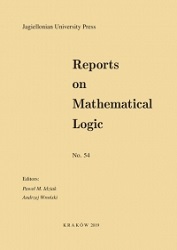Reductions Between Certain Incidence Problems and the Continuum Hypothesis
Reductions Between Certain Incidence Problems and the Continuum Hypothesis
Author(s): Samuel G. Da SilvaSubject(s): Logic, Analytic Philosophy
Published by: Wydawnictwo Uniwersytetu Jagiellońskiego
Keywords: Continuum Hypothesis; incidence problems; complexity; Dialectica Categories;
Summary/Abstract: In this work, we consider two families of incidence problems, C1 and C2, which are related to real numbers and count- able subsets of the real line. Instances of problems of C1 are as follows: given a real number x, pick randomly a countable set of reals A hoping that x ∈ A, whereas instances of problems of C2 are as follows: given a countable set of reals A, pick randomly a real number x hoping that x ∉ A. One could arguably defend that, at least intuitively, problems of C2 are easier to solve than problems of C1. After some suitable formalization, we prove (within ZFC) that, on one hand, problems of C2 are, indeed, at least as easy to solve as problems of C1. On the other hand, the statement “Problems of C1 have the exact same complexity of problems of C2” is shown to be an equivalent of the Continuum Hypothesis.
Journal: Reports on Mathematical Logic
- Issue Year: 2019
- Issue No: 54
- Page Range: 121-143
- Page Count: 23
- Language: English

